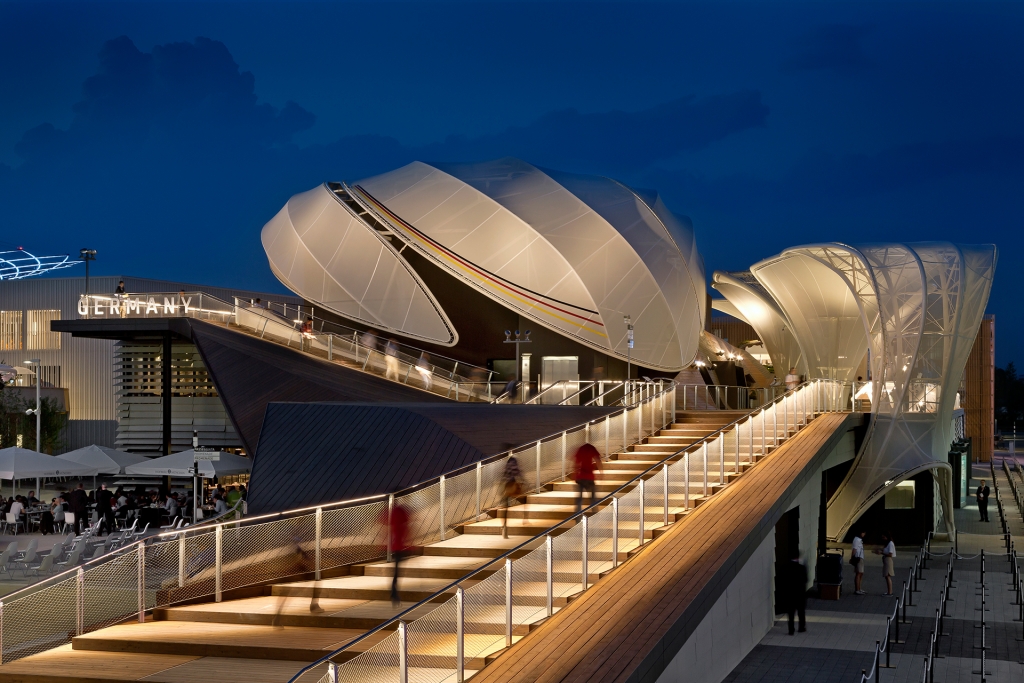

What does technology have to offer that can guarantee healthy, safe, and sufficient food for everyone, while still respecting the balance of nature? This is the question posed by the Expo Milano 2015 to each of its 140 participating countries, which in turn created exhibits showcasing their answers. From May 1 to October 31, visitors can experience everything from Austrian measures to increase air purity to the joys of the Greek diet, across a 11.8-million-square-foot exhibition area.
 The German contribution, a 40-foot-tall “smart” pavilion, flaunts flexible organic photovoltaic (OPV) solar trees across its façade and roof. Manufactured by Belectric OPV, solar cells harvest energy throughout the day for use in illuminating the pavilion at night. And while the inside of the “Be Active” exhibition, sponsored by the German Federal Ministry of Education and Research, presents fascinating examples of the significance of nature to our understanding of nutrition, the building’s exterior will give the print world plenty to contemplate.
The German contribution, a 40-foot-tall “smart” pavilion, flaunts flexible organic photovoltaic (OPV) solar trees across its façade and roof. Manufactured by Belectric OPV, solar cells harvest energy throughout the day for use in illuminating the pavilion at night. And while the inside of the “Be Active” exhibition, sponsored by the German Federal Ministry of Education and Research, presents fascinating examples of the significance of nature to our understanding of nutrition, the building’s exterior will give the print world plenty to contemplate.
OPV technology, which in a nutshell is the generation of an electric current from absorbed sunlight, began  developing as early as 2001, but the keyword “flexible” brings the accomplishments of the pavilion to another level. In the past, OPV modules were printed onto rigid panels on which the circuit patterns – composed of specific gaps and contact points in the cell’s layers – were predetermined. This was a strictly additive process, and one that didn’t allow for much in the way of architectural imagination. But things have recently changed.
developing as early as 2001, but the keyword “flexible” brings the accomplishments of the pavilion to another level. In the past, OPV modules were printed onto rigid panels on which the circuit patterns – composed of specific gaps and contact points in the cell’s layers – were predetermined. This was a strictly additive process, and one that didn’t allow for much in the way of architectural imagination. But things have recently changed.
Advertisement
 “Over the last two years we have added the ability to do freeform devices,” says Dr. Ralph Pätzold, CEO of Belectric OPV. “This has given us a lot of freedom.” In addition to OPV’s lightweight, ultra-thin qualities, this added flexibility in both concept and structure gives clients a more cost-effective and customizable option, rather than having to work around design constraints dictated by the technology. “This is the first time ever that a full OPV system was driven by an architectural mindset,” he continues. “We are no longer defining ourselves by layout.”
“Over the last two years we have added the ability to do freeform devices,” says Dr. Ralph Pätzold, CEO of Belectric OPV. “This has given us a lot of freedom.” In addition to OPV’s lightweight, ultra-thin qualities, this added flexibility in both concept and structure gives clients a more cost-effective and customizable option, rather than having to work around design constraints dictated by the technology. “This is the first time ever that a full OPV system was driven by an architectural mindset,” he continues. “We are no longer defining ourselves by layout.”
The ability to manufacture customizable, freeform cells was made possible by the incorporation of laser scribing technology, a subtractive process. Belectric coats all of the layers, made of a flexible PET plastic, on a basic roll-to-roll coater, with no preconceived structure. Then, once the customer’s design is received, lasers are used to selectively remove layers at specific points to create the desired circuitry patterns. The topmost layer is then printed with an organic, semi-conductive ink – formulated in-house from a thermo-contacting powder – on a modified roll-to-roll press.
Belectric coats all of the layers, made of a flexible PET plastic, on a basic roll-to-roll coater, with no preconceived structure. Then, once the customer’s design is received, lasers are used to selectively remove layers at specific points to create the desired circuitry patterns. The topmost layer is then printed with an organic, semi-conductive ink – formulated in-house from a thermo-contacting powder – on a modified roll-to-roll press.
How will this add to the range of new technologies made possible by OPV?

“This is just one excellent example of a self-sufficient energy installation through the use of OPV,” says Dr. Klaus Hecker, managing director of the Organic and Printed Electronics Association. “A manifold of new product opportunities arises, ranging from small charging devices integrated in bags or clothing and solar cells on car rooftops, to entire building facades.”
Perhaps sooner than we think, “photovoltaic” won’t be a mouthful of a word; it’ll be something we can’t leave home without.
Advertisement
Explore other industrial printing projects from our August/September issue:
Loggerhead Deco: Sustainable Success

The Magic Is in the Money

Graphic Overlays Take Flight
Advertisement
.JPG)


 Art, Ad, or Alchemy1 month ago
Art, Ad, or Alchemy1 month ago
 Case Studies1 month ago
Case Studies1 month ago
 Andy MacDougall1 month ago
Andy MacDougall1 month ago
 Columns2 weeks ago
Columns2 weeks ago
 Editor's Note2 weeks ago
Editor's Note2 weeks ago
 Thomas Trimingham2 months ago
Thomas Trimingham2 months ago
 Marshall Atkinson2 weeks ago
Marshall Atkinson2 weeks ago
 News & Trends1 month ago
News & Trends1 month ago























